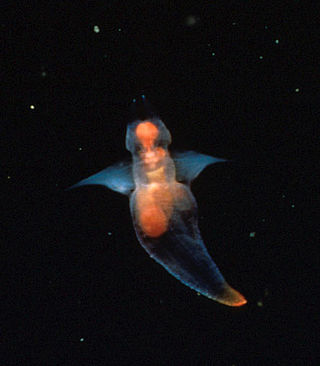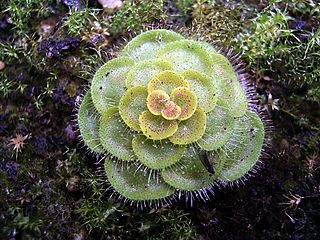
The Clionidae are a family of sea angels, which are a group of pelagic marine gastropods.

Thaliacea is a class of marine chordates within the subphylum Tunicata, comprising the salps, pyrosomes and doliolids. Unlike their benthic relatives the ascidians, from which they are believed to have emerged, thaliaceans are free-floating (pelagic) for their entire lifespan. The group includes species with complex life cycles, with both solitary and colonial forms.

Pyura is a large genus of sessile ascidians that live in coastal waters at depths of up to 80 m (260 feet). Like all ascidians, Pyura are filter feeders. A few species, including Pyura chilensis are commercially fished.

A salp or salpa is a barrel-shaped, planktonic tunicate in the family Salpidae. It moves by contracting, thereby pumping water through its gelatinous body; it is one of the most efficient examples of jet propulsion in the animal kingdom. The salp strains the pumped water through its internal feeding filters, feeding on phytoplankton.

Clavelinidae is a family of tunicates in the order Aplousobranchia.

Didemnum is a genus of colonial tunicates in the family Didemnidae. It is the most speciose genus in the didemnid family. Species in this genus often have small calcareous spicules embedded in the tunic and form irregular or lobed colonies. Some Didemnum species, including Didemnum vexillum and Didemnum perlucidem are considered invasive species. In early 2006, Didemnum vexillum was found covering a 230 km2 area of cobble habitat in Georges Bank off the coast of New England, and is classified as an invasive species of greatest concern in coastal areas throughout Europe, New Zealand, and North America. Didemnum sp. invasions have also been recorded in Canada, the Mediterranean, and the Netherlands.

Clavelina is genus of sea squirts, containing the following species:

Drosera zonaria, the painted sundew, is a perennial tuberous species in the carnivorous plant genus Drosera and is endemic to south-west Western Australia from near Perth southeast to near Esperance. It grows in a tight rosette approximately 5 to 7 cm in diameter with 20 to 30 green to red leaves that are arranged in concentric layers. The leaves are typically 1 cm wide and are usually described as being "kidney-shaped" with crimson leaf margins. It grows in deep silica sands in open woodland or coastal heathland and only flowers after a bush fire, which is speculated to be caused by the release of ethylene. Its white, sweetly perfumed flowers, which are very similar to those of D. erythrorhiza, emerge on 4 to 5 cm tall scapes. As with most other tuberous Drosera species, D. zonaria will die back during the dry summer months and retreat to the fleshy tuber 10 to 30 cm below ground.

Stolidobranchia is an order of tunicates in the class Ascidiacea. The group includes both colonial and solitary animals. They are distinguished from other tunicates by the presence of folded pharyngeal baskets. This provides the etymology of their name: in ancient Greek, στολίς, ίδος means the "fold" of a cloth. Stolidobranchian sea squirts are also characterized by the complete absence of an abdomen. The abdominal organs of other tunicates are instead located to one side of the pharyngeal basket in this group.

Acanthina, common name the unicorn snails, is a genus of small predatory sea snails, marine gastropod mollusks in the family Muricidae, the murex snails or rock snails.

Multifurca is a rare genus of ectomycorrhizal fungi in the family Russulaceae. It was described in 2008, after molecular phylogenetic study had shown that it forms a monophyletic lineage within the family, sister to Lactarius. The genus contains six species known from the United States, Mexico, Costa Rica, India, China, Thailand, Australia, and New Caledonia, but so far has not been reported from Europe, Africa, or South America. Four of those species were formerly classified as Russula section Ochricompactae, and Multifurca furcata was originally described as a Lactarius species.

Trophon is a genus of sea snails, marine gastropod mollusks in the family Muricidae, the murex snails or rock snails.

Zonaria is a genus of sea snails, marine gastropod molluscs in the subfamily Zonariinae of the family Cypraeidae, the cowries.

Pycnoclavella diminuta, known as the white-spotted sea squirt, white-spot ascidian, and white-spotted ascidian, is a species of tunicate, in the genus Pycnoclavella. Like all ascidians, these sessile animals are filter feeders.
Stolonica is a genus of ascidian tunicates in the family Styelidae.

Sycozoa pulchra, is a sea squirt in the family Holozoidae, first described by William Abbott Herdman in 1886 as Colella pulchra. The taxonomic decision which determined the name, Sycozoa pulchra, and the species' synonymy was given by Patricia Kott in 1990.

Herdmania grandis is a species of sea-squirt in the family Pyuridae.

Asterocarpa humilis is a species of ascidian tunicate first described in 1878 as Styela humilis by Camill Heller.
Herdmania pallida is a species of sea-squirt in the family Pyuridae.
Anadistoma is a monotypic genus of tunicates belonging to the order Aplousobranchia. The sole species in this genus is Anadistoma attenuatumKott, 1992. The species and the genus were first described in 1992 by Patricia Kott.

















